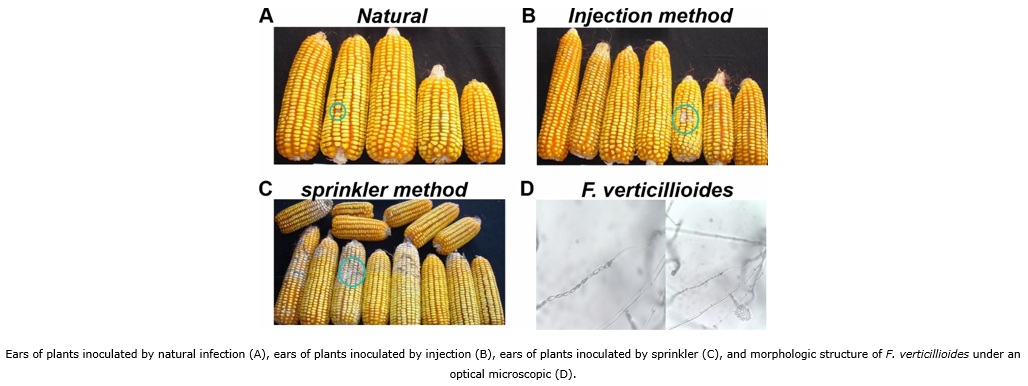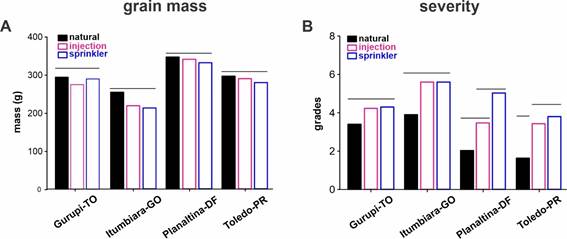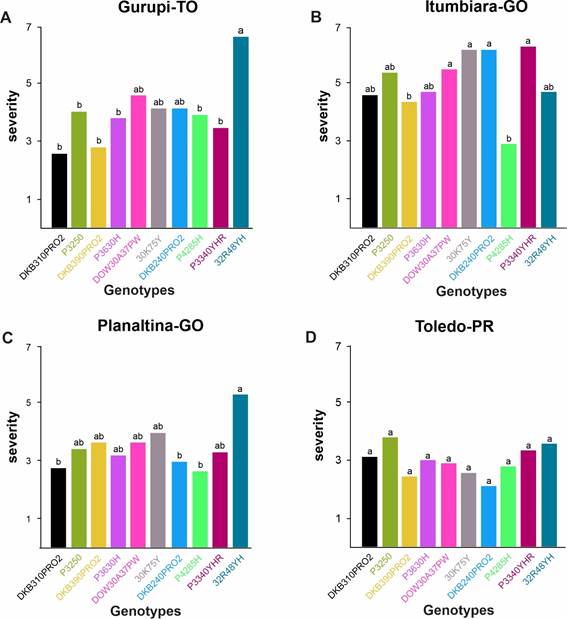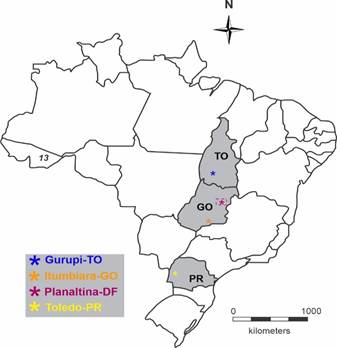INTRODUCTION
Corn, zea mays L., is planted in all regions of the neotropical region, including brazil and the world, being cultivated under a wide range of climate and growing conditions. brazil is one of the world's largest producers of corn, being surpassed only by the usa and china (Erenstein et al., 2022); the estimated national production in 2022 is set to reach 38 million tons (CONAB, 2022). Compared with wheat and rice, corn is of great importance in daily human life, being used as a livestock feed crop, as an industrial or energy crop, and for the manufacture of the most varied products (Zhao et al., 2018; Zhang et al., 2021; Veljković et al., 2018; Erenstein et al., 2022). Under field conditions, corn productivity is often compromised by the occurrence of diseases, especially those caused by fungi infestations, damaging various parts of plants. Therefore, several factors must be considered to guarantee the best conditions for the development of the hybrid.
Fungal diseases, especially those caused by species of the genus Fusarium, are among the main ones associated with the corn fields in Brazil. Fusarium fungi attacks on the plant roots and stem are the main causes of burnt grains that compromise production, in most cases being identified only in processing centers. Ear rot is among the most important and difficultly controlled diseases, reducing the quantity and quality of grains (Gaikpa & Miedaner, 2019; Gai et al., 2018; Zhou et al., 2018). The main routes of pathogen infection in corn ears occur through the style stigma and by wounds in the grains, causing deformation (Thompson & Raizada, 2018; Modrzewska et al., 2022). These pathogens can also produce mycotoxins, which can cause poisoning in humans and animals, with fumonisin being the main mycotoxin found in contaminated corn grains (Carvajal-Moreno, 2022; Chen et al., 2021).
To prevent the establishment of Fusarium fungi, plant resistance to the pathogen is crucial for breeding programs. For this purpose, elucidating resistance sources is a starting point for obtaining interesting hybrids. (Mesterhazy, 2020). Several techniques of artificial inoculation were described for this characterization: whether by spraying of suspension of conidia, spore injection, insertion of sticks colonized by the pathogen, infected grains through wounds with steel pins immersed in macroconidia suspension, or infected through injection of inoculum into the grains (Zhang et al., 2018; Li et al., 2022; Jiang et al., 2021; Bamisile et al., 2018)
Despite the mentioned effectivity of inoculation methods, the characterization of resistant genotypes is still ineffective when we consider field conditions with different climatic characteristics. In Brazil, four important corn-producing regions (i.e. Gurupi-TO, Itumbiara-GO, Planaltina-DF, and Toledo-PR) contrast concerning environmental temperatures. In this way, this work aimed to compare three methods of inoculation of F. verticillioides in ten maize genotypes, quantifying the severity of the disease and its effects on productivity in these four regions of Brazil.
Fusarium verticillioides infections are influenced by temperature (Murillo-Williams & Munkvold, 2008; Garcia et al., 2012). Thus, we hypothesize that since these regions have different temperature average levels, the efficiency of the evaluated inoculation methods could vary in each experimental field location. Surely, the characterization of genotypes regarding horizontal or partial resistance to ear rot disease may be more efficient, and such results will be relevant for obtaining more productive genotypes.
MATERIALS AND METHODS
Pathogen isolation, inoculum production, and Koch's Postulates. Symptomatic corn grains presenting F. verticillioides were used for pathogen isolation. Then, the fungus was subcultured into Petri dishes containing PDA (potato, dextrose, and agar) growth medium (200g potato, 20g dextrose, and 20g agar per liter). The presence of long chains of microconidia produced in monophialides were the typical morphology used in the F. verticillioides characterization (Rosa Junior et al., 2019; Leslie & Summerell, 2008).
In the purification of the isolated colonies, we used the technique of monosporic culture (Fernandez, 1993). Briefly, the conidia suspension was placed in 5mL of distilled water and sterilized in Petri dishes containing agar-agar growth medium (20g of agar per liter). The Petri dishes were incubated at room temperature for 24h. Posteriorly, the germinated conidia were observed under an optical microscope and separately transferred to experiment tubes and Petri dishes containing PDA growth medium for storage and further bioassays. Inoculations of 5 x 105 conidia/mL suspensions were applied in healthy plants of the 32R48YH hybrid to perform Koch's Postulates.
Inoculations were made one day in the style stigma, and the other in the center of the ear. The plants were used at the R1 phenological stage. After 25 days of inoculation, all ears were harvested for plating and identification of the pathogen present in the grains.
Molecular identification of isolates and DNA amplification by PCR. The DNA of F. verticillioides was extracted in the Phytopathology Laboratory of Corteva Agriscience from Brazil Ltda, located in Porto Nacional-TO, according to the protocol described by Doyle (1991). For DNA amplification by PCR, the primer pairs used in the reaction were: VER-1 (5'-CTT CCT GCG ATG TTT CTCC-3') and VER-2 (5'-AAT TGG CCA TTG GTA TTA TAT ATCTA -3') to amplify the specific calmodulin gene from F. verticillioides isolates. A second PCR analysis and confirmation were performed in the Agronomic Laboratory, accredited by the Ministry of Agriculture, through sequencing from the same sample submitted to the previous PCR analysis.
Experiment locations and weather conditions. The experiments were carried out in the 2015/2016 agricultural season in experimental corn crops located in four Brazilian cities: Gurupi (North Region, Tocantins State), Toledo (South Region, Paraná State), Planaltina (Center-West Region, in the Federal District) and Itumbiara (Central-West Region, state of Goiás) (Figure 1).
Gurupi belongs to the Cerrado Biome at 278m altitude, which has a hot and humid tropical climate, while Toledo belongs to the Atlantic Forest Biome, which has a subtropical climate. In these two cities, the experiments were carried from February to July 2016. Planaltina city is part of the Cerrado Biome, sited up to 1175m; and the city of Itumbiara is in the Cerrado and Atlantic Forest Biome, up to an altitude of 448m. Between December 2015 and April 2016, the bioassays were carried out. The climate defined for the mentioned cities is type Aw, except for Toledo city, which is type Cfa.
The maximum and minimum temperatures (in ºC) of the four sites were evaluated from the inoculation to grain harvest periods. In each of the four planted areas, a mini-weather station was installed to record the climatic variables. This structure was composed of an electric pump coupled to an irrigation system connected to micro nebulization sprinklers. A timer controlled the activation of the entire system. The nebulization schedule on the plants was the same in all locations of the experiments, with a total of twelve per day, lasting five minutes each, starting at 8:00h until 20:00h. In this way, it was possible to prove a favorable microclimate for the development of the disease in the ears.
Inoculation treatments and experimental design. The experimental design was carried out in randomized blocks in a 10 x 3 factorial scheme, with 10 maize genotypes treated with the fungicides Metalaxil-M (10g/L) and Fludioxonil (25g/L) and three inoculation methods (i.e. natural, injectable and sprinkling). The following genotypes were used: DKB310PRO2, P3250, DKB390PRO2, P3630H, DOW30A37PW, P30K75Y, DKB240PRO2, P4285H, P3340YHR and P32R48YH.
The experimental plots under field conditions consisted of 6 rows of 4.5 m with 30 plants each. Each inoculation method was used in 2 rows and totaling 3 blocks. In the natural infection treatment, all 30 plants in each row were inoculated. However, the first two and the last two plants were not inoculated for the artificial methods. No fungicide was applied to the plants in the experiments.
The F. verticillioides suspensions of inoculations were obtained from a PDA culture medium. The fungus mycelia, in a 15-day-old growth medium, were ground in a blender. Later, this fungi-PDA growth medium was sieved to remove coarse particles from the growth medium. Then, the conidia were counted using a hematocytometer at concentration of 5 x 105conidia/mL. In both methods of artificial inoculation, 2mL of this suspension per ear was inoculated. The plants were used when they were in the R1 phenological stage, which is characterized as "flowering and pollination". At this stage, there is a high susceptibility to infections, with the stylo stigma starting to darken between the seventh and tenth day after flowering begins (Munkvold & Desjardins, 1997).
For the injectable method, the conidial suspension was inoculated using an automatic feeding dosing syringe into the center of the ear. The injectable method simulates the infection of corn cobs by the fungus from physical damage caused to the ears, mostly caused by insects. For the sprinkling method, the inoculation of the conidia suspension was performed with the aid of a properly sterilized water sprayer containing the inoculum, which was deposited under the stylo-stigma of the ear. The sprinkling method in the form of spray simulates the natural dissemination of spores that reach the stigmas of the ears. The natural inoculation method was used as a control of the experiments.
The ears were covered with a paper package, thus providing a better environment for pathogen development after inoculations, as well as serving as a barrier to avoid interference from other experimental plots.
Harvest of ears and evaluations of thousand-grain mass and severity. When the plants reached the physiological maturation (phenological stage R6), the monitoring of grain moisture was started until it reached the level of 17%. Then, 50 ears for each inoculation method were harvested, totaling 150 ears. Subsequently, the grains were collected after the ears reached 13% moisture with the aid of an automatic dryer.
Immediately after harvesting the ears, determinations of the mass of one thousand grains (g) were carried out by counting one thousand grains for all repetitions of each treatment. Further weighting in a calibrated scale by a certifying company with quality control supported by the NBR ISO IEC17025:2005 standard (NBR: Brazilian Standard; ISO: International Organization of Standardization; IEC: International Electrotechnical Commission) was performed. Standard 17025:2005 is a quality management system standard for laboratories.
The disease severity was evaluated moments before the threshing of the grains when they were harvested. The evaluation was done considering the visual aspects of the ears by assigning a scale of notes visually and comparatively. Injured areas of ears were those that presented white to pink mycelium and the darkened grains and/or white streaks in the pericarp. The categories of severity assigned were: Grade 1 = 0% (healthy), 2 = 0.5%, 3 = 10%, 4 = 30%, 5 = 50%, 6 = 70%, 7 = 80%, 8 = 90% and 9 = 100% of the ear area with symptoms of rot (Agroceres, 1996 ). The resistance levels of the genotypes were classified as follows: high to medium resistance (1 to 3 scores), medium susceptibility (4 to 6 scores), and medium to highly susceptible (7 to 9 scores).
Statistical analysis. For data from each location, an analysis of variance (ANOVA) was performed. A joint analysis of variance was also performed, considering the data from all locations. Means of factors and significant interactions were compared using Tukey's test (SAS, 2003). The normality and homogeneity were also checked, and the transformation of data that did not reach these parameters was performed by the Box-Cox methodology.
RESULTS AND DISCUSSION
Molecular identification of isolates. The amplified fragments from DNA samples of fungal isolates obtained from rotten ears containing symptomatic grains can be seen in Figure 2. The sample resulted in 658 and 986 nucleotides for the EF and RPB2 regions, respectively. This sequence showed 99% identity with F. verticillioides (Accession No. FN179338.1) and (Accession No. FN552106.1), respectively, covering 99% of the sequence (Query cover), according to BLAST (NCBI) consultation, Icl /Query_25443, and Icl/Query_10149, according to the Plant Health report 3162/2017-AGR.
Fusarium verticillioides infection and inoculation methods. After inoculation of F. verticillioides, the reproduction of Fusarium symptoms in corn cobs was verified both in plants by natural infection (Figure 3A), inoculated by injection (Figure 3B), and the inoculated by sprinkler (Figure 3C). In these samples, the morphological structures of F. verticillioides were also identified under an optical microscope, and conidiophores with chain microconidia and long-chain microconidia in monophialides were observed (Figure 3D). As well as the same morphological characteristics previously observed were verified through the re-isolation of the pathogen.

Figure 3 Fusarium symptoms in maize ears after inoculations. Ears of plants without using artificial inoculation methods.
We found that the interaction inoculation method - genotype was not significant for thousand-grain weight and severity; however, the isolated effect of each of the inoculation methods was significant (P <0.05) (Table 1). Specific analyzes were not performed considering the genotypes in each site, as the response pattern of the materials was similar for all inoculations.
Table 1 Analysis of variance for thousand-grain mass and severity. Analyzes were performed considering three methods of inoculation of Fusarium verticillioides in 10 commercial corn genotypes planted in four different locations in Brazil.
| Thousand-grain mass | Severity | ||||||||
|---|---|---|---|---|---|---|---|---|---|
| SV | DF | MS | Fc | Ftab | MS | Fc | Ftab | ||
| Block/Location | 8 | 753.6 | 205.7 | 1.9 | * | 0.1 | 1.1 | 1.9 | ns |
| Inoculation (I) | 2 | 13290.9 | 4.9 | 3.0 | * | 121.9 | 41.3 | 3.1 | * |
| Genotype (G) | 9 | 16437.7 | 6.2 | 1.9 | * | 12.2 | 4.1 | 1.9 | * |
| I × G | 18 | 863.7 | 0.3 | 1.7 | ns | 1.8 | 0.6 | 1.7 | ns |
| Location (L) | 3 | 184416.2 | 53.9 | 2.7 | * | 69.9 | 22.7 | 2.7 | * |
| L ×Treatment (T) | 87 | 2667.6 | 727.9 | 1.3 | * | 2.9 | 26.7 | 1.3 | * |
| Average Error | 232 | 3.7 | 0.1 | ||||||
| Average: 285.2 | VC: 19.8 | Average: | 6.1 | VC: | 5.4 | ||||
*significant and ns not significant by the F test (p < 0.05); DF: degrees of freedom; MS: mean squares; Fc: calculated F-value; Ftab: tabulated F-value; VC: variation coefficient
The average temperatures observed in the places during the permanence of the experiments were: Gurupi, 28.43°C; Itumbiara, 23.1ºC; Planaltina, 22.13 and Toledo, 13.64°C. On the four sites, the inoculation method was not influenced by the thousand-grain mass variable (Figure 4A). However, for the experiments installed in Toledo and Planaltina, there was found less severity of the disease (P<0.05) when inoculated with the natural method (Figure 4B). Suggesting that although ear rot directly impacts the quality of the grains, as observed in figure 3, such changes did not lead to losses in grain mass.

Figure 4 Thousand-grain mass (A) and severity (B) of maize ears rot as a function of three inoculation methods of Fusarium verticillioides . Bars under the same line do not differ significantly by the Tukey test (P < 0.05).
The mean severity of the disease found among the three inoculation methods may be influenced by average temperatures. In this case, it suggests mechanisms that inhibit the infection or colonization of F. verticillioides may be involved, such as changes in growth patterns and mycotoxin production influenced by temperature (Garcia et al., 2012). In fact, a natural infection should be less efficient in environments where temperatures are mild, especially in the Toledo region (T = 13.64°C). In this regard, agro-climatic conditions, mainly temperature are known factors that directly influence the sporulation of F. verticillioides (Roucou et al., 2021; Pfordt et al., 2020; Leggieri et al., 2019). Thus, it is consistent that in places with higher temperatures, the efficiency of natural inoculation is similar to artificial methods. Furthermore, the inoculation of our experimental plants was carried out during the flowering period. And it is already known that during the flowering period, conditions of lower temperatures and more humid conditions limited the infection as Toledo (Kamle et al., 2019; Cao et al., 2014).
Schaafsma et al. (1993) ported that artificial inoculation methods using grain injuries and inoculum applications inside the bracts result in greater severity of ear rot under favorable conditions for the development of the pathogen. However, in our study, no form of covering was performed on the ears after inoculation was reported. These results contradict those found in the municipality of Planaltina, where inoculation by sprinkling was more severe.
Comparison of partial resistance in genotypes. Regarding the behavior of the genotypes, it was possible to observe that 32R48YH, DOW30A37PW, 30K75Y, and DKB240PRO2 genotypes presented the highest disease severity in Gurupi compared with other genotypes (P <0.05) (Figure 5A). In Itumbiara, the highest severity was observed for all the genotypes except for DKB390PRO2, and P4285H (Figure 5B). In Planaltina, higher severity was observed for genotype 32R48YH, while the genotypes DKB310PRO2, DKB240PRO2 and P4285H showed lower severity disease (Figure 5C). On the other hand, in Toledo, no significant differences were observed between the genotypes (P> 0.05) (Figure 5D).

Figure 5 Severity of ear rot in maize inoculated by Fusarium verticillioides in ten genotypes in four different places. Bars showed the means severity of infections in each genotype; the same letter in each bar does not differ significantly by the Tukey Test (p < 0.05) within each location.
When comparing the behavior of the genotypes in different cities, it was possible to conclude that the disease severity is very variable according to the place’s experimental conditions. In places with higher temperatures, it is possible to obtain a better classification regarding the susceptibility of the genotypes since Gurupi, Itumbiara, and Planaltina showed marked differences in relation to the ten evaluated genotypes. In Toledo, whose average temperature is milder, the genotypes did not show significant differences in severity, having received scores below 4: equally classifying the genotypes as moderately resistant.
Although no genotype was classified as highly susceptible or resistant, it was possible to observe that genotypes 32R48YH and P4285H present marked contrasts regarding the severity of the pathology. 32R48YH presented the highest severity both in Gurupi and Planaltina. Otherwise, the P4285H genotype presented the lowest severity in the cities of Gurupi, Itumbiara, and Planaltina, being able to be classified as moderately resistant in general.
In general, resistance to F. verticillioides is related to polygenic c inheritance, and the markers that have been identified are related to the oxidation-reduction process and peroxidase activity, in addition to transcription factors (De Jong et al., 2018). However, some morphological characteristics of each genotype could make it difficult to establish the infection through artificial methods. For example, style stigma resistance, which is the ability of the genotype to prevent the infection and colonization of the fungus into the style stigma canal, could hinder the establishment of infection after spraying the conidia. However, this mechanism is not fully understood and may be more complex than the former of a physical barrier (Yang et al., 2021; Thompson & Raizada, 2018; Łaźniewska et al., 2012). On the other hand, it is also reported that grain resistance delays the colonization of the pathogen in the ear once it has grown into the stigma-style canal or has been introduced by injury (Soni et al., 2020; Adeniji & Babalola, 2018; Zhang et al., 2012). Mesterházy et al. (2012) reported that resistance does not correlate in all genotypes when one of the two main modes of fungi infection occurs in the ear - through stigma-style or through grain wounds.
Inoculation methods influence the conduction of experiments that seek the selection of resistant genotypes to relevant pathogens affecting the corn crop. In general, studies that carry out evaluations of the efficiency of inoculation methods do not consider field conditions, which are highly variable in different regions of Brazil. Here, we demonstrate that the efficiency of artificial inoculation methods for F. verticillioides varies according to experimental sites, contrasting with each other in relation to the average temperatures in the evaluated periods. On the other hand, the differentiation of ten corn genotypes in terms of resistance and susceptibility to ear rot was more efficient in places with higher average temperatures.
CONCLUSIONS
The artificial inoculation methods proved to be efficient in relation to the natural inoculation method of F. verticillioides in corn ears in regions with higher average temperatures (Gurupi, Itumbiara, and Planaltina). Similarly, the characterization of corn genotypes regarding the degree of susceptibility to the pathology was not possible in the milder region (Toledo), observing contrasting susceptibilities only in the three other regions. The 32R48YH genotype showed medium susceptibility to the pathogen, while the P4285H genotype was moderately resistant. Considering our findings, the results demonstrate the importance of environmental temperature as a crucial factor for determining the efficiency of inoculation methods in the selection of genotypes that present partial or horizontal resistance to F. verticillioides.

















